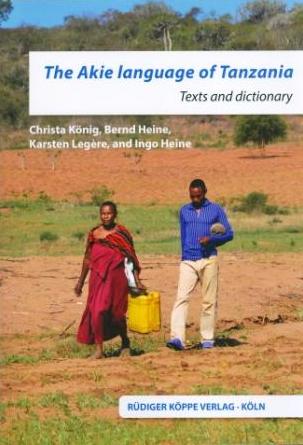
The Akie Language of Tanzania
Texts and Dictionary
Author: Christa König, Bernd Heine, Karsten Legère, Ingo Heine †. Series edited by: Bernd Heine, Wilhelm J.G. Möhlig †.
Series: EALD East African Languages and Dialects Volume 29
202014 pp. Roman, 332 pp.
88 colour photos, 1 drawing
Text language(s): English
E-book
€ 69.80
Buy 'The Akie Language of Tanzania' as a downloadable PDF document directly from our online shop »
There are few traditional hunter-gatherer societies left in the world. The Akie of the Maasai Steppe of Tanzania are one of them. The Akie call themselves akie (sg. akiántee) and their language kuuti táá akie (‘mouth of the Akie people’). The Akie inhabit the Kilindi District of Tanga Region and the Kiteto and Simanjiro Districts of Manyara Region of north-central Tanzania. Most of their homesteads are located in the mountaneous regions at the periphery of villages, and they are claimed to have been living in this general area long before all their neighbors arrived.
The Akie language is a member of the Kalenjin language cluster, which belongs to the Southern Nilotic branch of the Nilotic language family. The latter has been classified as belonging to the Eastern Sudanic branch of the Nilo-Saharan phylum, a genetic unit which was proposed by Greenberg (1963) but is not entirely uncontroversial. The language is endangered (Heine et al. 2014; 2015a), there are hardly more than 250 speakers left. Jointly with the grammatical treatment of the Akie language that was presented earlier (König et al. 2015a), this study is intended to contribute to the documentation of the language and their culture.
The main objective of the project – sponsored by the Volkswagen Foundation – was to video-record the use of and the knowledge that the Akie have about their language. The texts presented in Part 4 constitute only a selection of all the texts collected in the course of our research. The lexical treatment in Parts 5 and 6 are not conceived as a comprehensive dictionary. Nevertheless, an attempt was made to document as much as possible of the cultural knowledge as it surfaces from the lexical resources found in our collection of Akie texts. You will find detailed information on plant use and plant taxonomy among the Akie people.
Under these links you will find descriptions of further Kalenjin languages, studies of African phytonyms / plant taxonomies and publications of the authors:
Accompanying material:
- A Dictionary of the Nandi Language
(ISBN 978-3-89645-134-7 ) - A Grammar of Belanda Boor
(ISBN 978-3-89645-664-9 ) - Cherang’any
(ISBN 978-3-89645-666-3 ) - Die südlichen Lwoo-Sprachen
(ISBN 978-3-89645-137-8 ) - Historical Language Contact in Africa
(ISBN 978-3-89645-091-3 ) - Mechthildian Approaches to Afrikanistik – Advances in Language Based Research on Africa
(ISBN 978-3-89645-226-9 ) - Nilo-Saharan – Models and Descriptions
(ISBN 978-3-89645-665-6 ) - The Mukogodo Maasai
(ISBN 978-3-927620-86-5 )
Cross-reference:
- A Tima-English Dictionary
(ISBN 978-3-89645-901-5 ) - Expérience végétale bolia (C.35b, République Démocratique du Congo)
(ISBN 978-3-89645-037-1 ) - Ik Dictionary
(ISBN 978-3-89645-133-0 ) - Kasus im Ik
(ISBN 978-3-89645-135-4 ) - Sprachhistorische Rekonstruktionen zu den Ursprüngen von Getreidenutzung und Gartenbau in Nordostafrika
(ISBN 978-3-89645-097-5 ) - Swahili Plants
(ISBN 978-3-927620-89-6 ) - The Noun Morphology of Western Nilotic
(ISBN 978-3-89645-139-2 ) - Wörterbuch Deutsch-Swahili
(ISBN 978-3-89645-346-4 )
Reviews
With The Akie Language of Tanzania by König et al., a wide-ranging study has been published that contributes to the necessary and helpful description of the Akie language. A Volkswagen Foundation research project funded by DoBeS (Documentation of Endangered Languages) made it possible to document and archive the Akie language in Tanzania within an adequate and necessary time frame.
The book is a collection of texts documented between 2013 and 2018, and represents only a fraction of the results of the large documentation project. Many of these, texts, but also other components, audio files and video files are stored electronically in the DoBeS Online Archive at the MPI Nijmegen.
The book consists of three parts: a short introduction to phonology and grammar, a text part and a dictionary (Akie – English, English – Akie), which the authors call a "list".
The first part, the Introduction, which the authors label "Notes on Grammar" contains the most basic phonological and grammatical explanations on 10 pages.
The second part, the text collection, comprises 16 texts that were recorded during the research period. These texts focus on the cultural and socio-economic issues that are central to the Akie. The first two texts refer to the Akie's conceptualisation of themselves and their origins, the following two texts to honey collection, a central economic basis of the modern Akie. Text 4 and text 5 address hunting, which, like honey-gathering, is performed exclusively by men and which plays a role in many basic rituals, social activities and oral traditions. The following sixth text on ritual activities describes the first of six rites-de-passage/rituals that are central to Akie culture. Two narratives by Akie women, six short folk tales and a blessing ritual follow this text.
The third part, the dictionary, comprises 125 pages with an Akie-English word list and 62 pages of an English-Akie word list, accompanied by 69 photos, each of which illustrates a word from the list. This actually gives the dictionary a very innovative and informative touch, as it makes it easier to imagine the terms that come from a society that is not very well described.
Angelika Mietzner in Afrikanistik-Ägyptologie.online, https://www.afrikanistik-aegyptologie-online.de/archiv/2021/5397, 1-2
| « back | Print version | [top] |
 Books
Books Audio
Audio Biographies
Biographies Series
Series Festschrifts
Festschrifts Journals
Journals